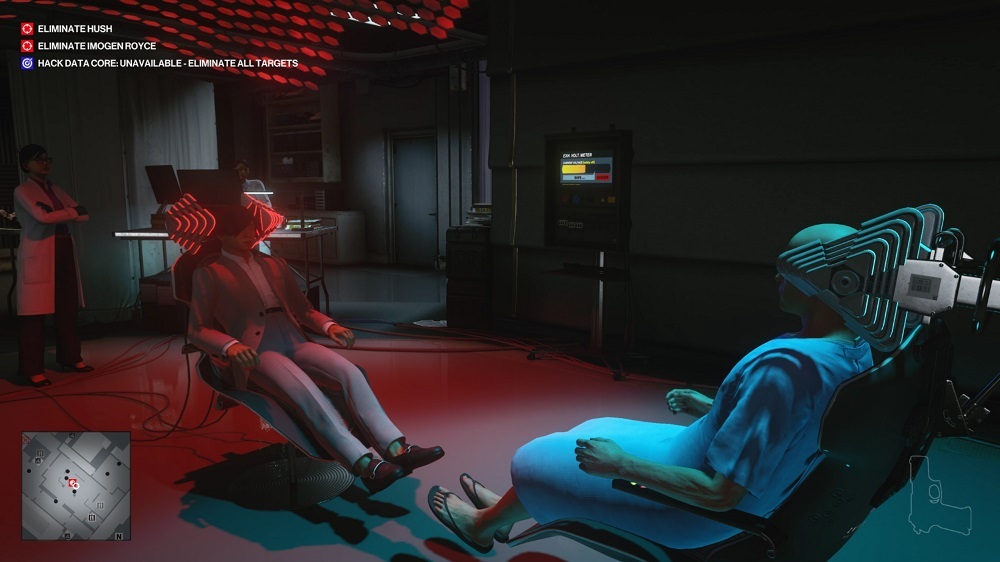Since it rebooted its Hitman franchise in 2016, IO Interactive has been putting on a level design masterclass. Each of the missions the developer rolled out in what it calls its World of Assassination series has contained a huge, intricate collection of scripted and free-form systems that create harrowing moments, presented elaborate puzzles to solve, and allowed the player to orchestrate ludicrous and often hilarious situations. Levels are designed to be played over and over so you can explore, understand, and eventually master all their moving parts, and it's impossible to see everything one has to offer in a single playthrough (or in most cases, even two or three).
At first blush, Hitman 3 appears to be more of the same. It makes no drastic changes to the underlying formula, instead adding a few graphical upgrades and quality-of-life improvements to the existing Hitman framework. But Hitman 3 improves on the World of Assassination through consistently excellent level design--which is saying something, given how strong all the previous missions are. Hitman 3 is full of fun and fascinating ideas, many of which play with the concepts underpinning the last four years of Hitman levels.
Presumably knowing that players have spent all sorts of time mastering its many settings and systems, IO throws in some brilliant curve balls that require you to use your assassin skills and knowledge in clever, challenging new ways.
In Hitman 3, all the stealth mechanics, the ways you can interact with the world, and enemy AI remain the same as in the past. That's essential to how Hitman works, however--your knowledge and understanding of the game's underlying systems are what make it possible to replay levels again and again to exploit their intricacies in different ways. Rather than feel dated, Hitman 3 just highlights how satisfying it can be to understand how all these moving pieces work together. There aren't any major mechanical additions to the game's construction, but seeing how it all harmonizes is as impressive today as it was when the first entry in the World of Assassination trilogy launched in 2016.
In each of the game's locations, your goal is to find a way to eliminate your assassination targets and then escape the level without being found out. You do that largely by knocking out enemies, hiding their bodies, and taking their clothes. Some areas are restricted based on what you're wearing, and some enemies can still see through your disguises, requiring you to carefully avoid them. Agent 47 has the benefit of Instinct, a vision mode that lets him intuit where enemies are through walls and which highlights interactive items in the environment.
As you sneak around each level, your goal is to try to uncover information that will help you get close to your targets and eliminate them. Those assassinations can be accomplished in simple ways, such as shooting them or strangling them with a garrote, or more complex ones like exposing an electrical wire in a puddle and then turning on a nearby switch to electrocute your prey. The stealthier (and less deadly to non-targets) you are, the better your score at the end of a level, and each stage is full of challenges to complete that encourage you to find weird and creative ways to take out your mark, without anyone knowing you were ever there. The more challenges you complete, the more you "master" a level, which unlocks additional starting locations and loadout options to change the experience even more.

Part of what sets Hitman 3's levels apart from those of Hitman 1 and 2 is how they fit into the overall story that IO has been telling in this series. In the past, each of Hitman's levels has functioned as a mostly standalone chapter in the tale of titular assassin Agent 47. You'd go into a location with one or more targets, and each mission had a bit of story about the people you were after, which doubled as an opportunity to get close to them.
But those targets were usually somewhat tangentially related to what was going on in the unfolding story of Agent 47 and his handler, Diana Burnwood. Across Hitman 1 and 2, the pair slowly realized that they were unwitting participants in a war between the Shadow Client, a guy who was carefully manipulating them through their assassination contracts, and Providence, an Illuminati-like organization of world-controlling super-rich people. In Hitman 3, Agent 47 and Burnwood are fully involved in the battle against Providence after the events of Hitman 2, and that larger story is finally at the forefront of everything that's going on.
That means that missions feel like they have a bigger impact and targets are more interesting and make more sense. The characters you eliminate have consequences for the story, and those consequences lead to imaginative takes on the series formula as 47's enemies try to fight back against him. After developing a brilliant mold for Hitman missions, where you're dropped into an often-huge area and have to learn to understand how it works to accomplish your goals, IO breaks that mold again and again to create fun, memorable, inventive assassination experiences.
Much has already been made of the excellent second mission, set in Dartmoor, England, where you're trying to assassinate a target in the middle of what is essentially a riff on the movie Knives Out or any number of Agatha Christie stories. You're planning a murder of your own, but one has just taken place in the huge mansion where your target is staying, and you can even take on the role of private investigator and search for clues to figure out whodunit. It feels like taking a brief vacation in the middle of Hitman 3 to play another game, but the brilliance of the murder mystery's addition is that the whole time you're solving it, you're thinking about how you can use the information you learn to your advantage to finish your assassination. Your inquiry might let you expose the murderer, or frame someone else for the crime, or give you ammunition for a blackmail threat, depending on how much you explore. It's a three-dimensional chess game where you're not only putting the clues together to close the case, but also thinking ahead to what opportunities your actions might offer you, and it's an absolutely phenomenal expansion of how Hitman's intricate levels already work.

Later missions also put intelligent spins on the series framework. Just about every Hitman mission up to now has given you a briefing about your targets and lets you plan your starting point and weapon loadout--so one mission robs you of all your preparatory information, dropping you into an unfamiliar location and forcing you to wing it, locating your targets and learning what you can about them on the fly. Another mission takes the things that work about Hitman--sneaking past guards, donning disguises, using the environment to distract or pacify enemies--and shrinks the scope from its normally expansive settings to a tight, crowded train, so that every move and decision you make has to be quick and calculated. There’s a mission that purposely leaves you on the back foot at one point when an alarm is activated, forcing you to sneak or fight your way to safety as guards search for you.
None of Hitman 3's missions change how you've played these games since 2016. They don't throw new mechanics at you (other than a camera that can scan some objects and persistent shortcuts that give you new opportunities for assassinations) or require you to learn to deal with new enemy behaviors. Instead, Hitman 3 finds new ways to challenge seasoned assassins purely through excellent design. You've honed your assassination skills--but can you solve a mystery? Can you avoid other hidden, disguised assassins hunting you? Can you sneak out of a locked-down facility full of soldiers who know you're there? It's a fitting testament to how strong the World of Assassination games have been all along that IO can make Hitman 3 feel fresh and new simply by finding creative new ways to take advantage of the series' design foundations.
The drawback of Hitman 3 is that, while the missions often feel even more ambitious in intricacy than those of the past, the game itself is scaled down somewhat as an overall package. Gone are some additions that appeared in Hitman 2, including the competitive Ghost mode and cooperative Sniper Assassin missions (the Sniper Assassin missions still exist as single-player experiences, but only if you own the content from Hitman 2).
There's an argument to be made that IO has maintained its focus on what people like about the series in Hitman 3 while letting experiments that worked less well fall away, but it still feels like there's a bit less game here than in the past. That said, the World of Assassination games also have excelled with their post-release content, and we know that the timed Elusive Target missions are making a return at some point, which softens the blow of multiplayer mode losses. There's also the addition of virtual reality support for PlayStation players, allowing you to play Hitman 3 in first-person mode (along with all the missions from Hitman 1 and 2, if you own them), although we played on PC and thus couldn't test it.

And as with Hitman 2, Hitman 3 functions as a platform for past games' levels, so you can play everything from Hitman 1 and 2 with your new unlocked weapons and Hitman 3's improvements. Continuing to have access to all Hitman content in one place is a nice addition, although you have to have purchased it all at some point or another.
What's good about Hitman--its level design and the creativity, experimentation, and exploration that affords--is great in Hitman 3. It closes out the trilogy by brilliantly playing off everything that came before it, making use of and then subverting expectations, and rewarding players for their willingness to master the complexity of both its individual levels and the series as a whole.





























